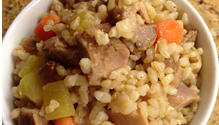By Amanda L. Andrei

Bread. Cake. Noodles. French fries. Tempura. Hoisin sauce.
No, these aren’t just banned items on a low-carb diet. These are foods and condiments that often contain gluten, a substance commonly found in wheat and related grains which causes baked goods to be chewy, dough to rise, and unfortunately, serious allergic reactions to some people. An allergy to gluten is known as celiac disease. Within the Asian Pacific American community, very little research has focused on gluten intolerance, allergies, and celiac disease.
These conditions can often be misdiagnosed, especially since symptoms between intolerances, allergies, and celiac disease can overlap. According to Dr. James Li from the Mayo Clinic, an intolerance to a food means that a person can usually eat small amounts of the food without negative reactions, while an allergy affects the immune system and can be caused by even tiny traces of the food. And in the case of gluten, intolerances and allergies can often be confused with celiac disease, an autoimmune disorder in which the small intestine is severely irritated and subsequently damaged and unable to pass nutrients to the rest of the body.
A study in 2006 estimated that approximately 3 million Americans suffer from celiac disease—more than the number of Americans diagnosed with Alzheimer’s disease. However, there exists little data on how this breaks down among racial lines. A survey in 2003 determined that the estimated prevalence of celiac disease in African, Latino, and Asian Americans was 1 in 236. Considering that celiac disease may be caused not only from a heavily gluten-dependent diet and genetically modified crops, the disorder can also be hereditary, making it crucial to understand it as it pertains to different communities.
Gluten intolerance, allergies, and celiac disease can be difficult to diagnose. Children and adults alike can have no symptoms, yet turn up positive for the disease in a blood test. Some symptoms can seem unrelated—like fatigue, joint pain, and anemia. As a result, it can take years before a patient is properly diagnosed.
Asian diets have relatively less wheat and grains compared to western diets, and the main dietary staple, rice, fortunately has no gluten. Thus, many Asians may have a gluten sensitivity and not realize it. In addition, many products, especially sauces, may use wheat as a thickener. Check the labels on soy sauce, hoisin, oyster sauce, and other pastes and condiments. Those with serious gluten reactions, may want to avoid these products altogether, as the food may have been processed in a facility that also processed wheat products.
If you suspect you may be allergic to gluten (or other foods), check with your doctor or dietitian. Keep a food diary for at least one to two weeks, recording the foods you eat and any symptoms you experience. You can also try an elimination diet—removing all potential triggers from your diet and gradually adding one food back every few days or so. Keep in mind, though—it may take months to go through this process, but will save much money and aggravation if the issue is properly identified.
Transitioning to a gluten-free diet is not easy, especially when food is an important part of one’s cultural heritage. There are some dishes and treats that just can’t be replicated, but fortunately, many substitutions are available. For instance, there are many noodles and wrappers that are made of rice (or other starches, such as sweet potato or buckwheat) and can serve as alternatives to wheat noodles. Just remember to check the labels on all products. And be cautious when eating in restaurants—even if a dish looks like it may be gluten free, it may have an ingredient like soy sauce that makes it an irritant to a gluten-sensitive individual.
So all that bread, cake, noodles? It doesn’t mean goodbye to these goods forever—just being creative in the kitchen and careful in restaurants. Especially when most gluten-free products on the market today focus on western food, it is particularly important for Asian Pacific Americans to recognize these potential triggers in Asian foods and adjust their diets accordingly.
Always check with your doctor or a licensed health practitioner before making any life-style changes.
Are you gluten-free? What are some of your best gluten-free recipes? Share them with us at Facebook or on Twitter @asianfortune_dc
 Asian Fortune Your source for all things Asian American
Asian Fortune Your source for all things Asian American




3 comments
Pingback: allergies gluten | AllergyHalt.com
Pingback: Flavors of Asia: Food Allergies [BLOG] | Asian Fortune
Pingback: Flavors of Asia: Food Allergies [BLOG] : Allergies Causes, Care and Treatments